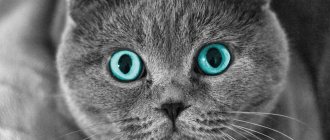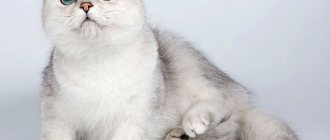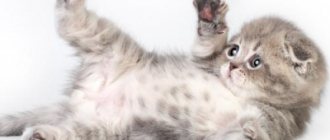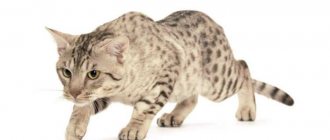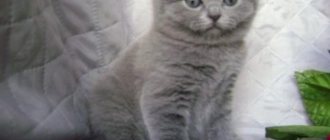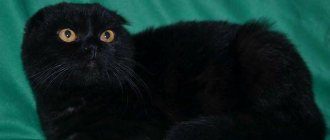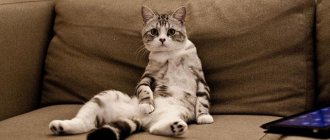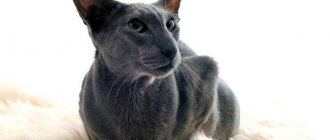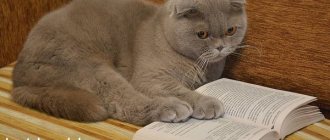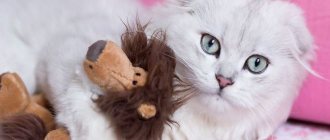Proper feeding and care of a Scottish Fold kitten is the key to the proper growth and development of a purebred pet. Scottish cats, like their relatives of the British breed, are unpretentious in maintenance and care. But the diet must be balanced, because the Scots are prone to a congenital disease in which degenerative processes are observed in the osteochondral system.
Animal hygiene
The Scottish Fold cat is considered one of the least problematic breeds. But, despite the fact that they are very clean, there are still some nuances in caring for Scots.
Eye care for Scottish Fold cats
Scottish Folds are not prone to excessive tearing, so caring for the eyes of a healthy cat does not cause any special problems. If a sick animal develops cloudy discharge, only a veterinarian can prescribe treatment. In this case, the pet needs daily eye treatment and cleansing of the fur around them.
Eye care for small Scottish Fold kittens will have to be organized almost daily. A fragile body is sensitive to all changes in temperature, weather, light conditions and instantly responds to them. Even bright light can cause discharge from a cat's eyes.
Care and cleaning of the ears of a Scottish Fold cat
The unusual structure of the auricle in the Scottish Fold cat requires special care for the hearing organs. At a young age, your pet’s cartilage is still weak and is easily injured by careless movement. Therefore, ears need to be cleaned with extreme caution.
For small kittens, the procedure is performed 1-2 times a week, and at a later age – once a month.
Scottish cats have their ears cleaned in several stages:
- The bent part is carefully lifted.
- Treat the auricle with a hygienic product using a cotton swab or swab.
- A cleansing agent is instilled into the ear canal, which in liquid form safely penetrates deep into the ear canal and neutralizes impurities. For Scottish Fold cats, it is recommended to purchase drops in a package with a long pipette. This makes it more convenient to administer the product and less likely to damage weak cartilage.
Important! The ears are the most vulnerable organ in straight-eared and fold-eared Scottish cats. Dirt accumulates in them and sulfur secretions are formed. It is because of poor ear hygiene that many inflammatory processes in the body begin.
Care of fur and claws
If you accustom your Scottish Fold cat to brushing from childhood, then in the future it will be much easier to care for its fur.
The owner of a longhaired Highland, unlike an ordinary Scottish Fold, will have to devote much more time to the luxurious coat of his pet. Without regular care, long hair becomes tangled, blood-sucking parasites multiply on the skin, and the cat begins to develop health problems.
Both adult Scottish Fold cats and small kittens need constant control of their claws. The pet should also be accustomed to this operation from childhood. Even if the animal actively uses the scratching post, it still needs to be “introduced” to the tools for trimming claws so that in the future the cat can easily endure the procedure.
Important! There are many small blood vessels on the paw pads. It is necessary to trim the claws very carefully so as not to damage the skin and to avoid bleeding in the cat.
At what age can British dogs be bathed?
A cat of noble blood needs washing at an early age more for beauty than for cleansing. After all, before an exhibition you need your fur coat to look well-groomed and shiny. A kitten can be bathed from three months old if it has long or thick hair and undercoat. Some veterinarians recommend starting no earlier than five months of age. This includes Persian, British, Scottish and other breeds.
Washing will bring many benefits:
- firstly, it will teach the baby to discipline;
- secondly, bathing allows you to remove static electricity from hairs;
- thirdly, it will remove dead epithelial scales and hairs, as a result, less of them will end up in the pet’s mouth and stomach.
Bathing a fold cat
Like any other cats, Scottish Folds do not like water. But if you teach a kitten to bathe from childhood, in the future he will not resist the procedure much.
In order to minimize stress when a cat comes into contact with water, you need to adhere to the following rules:
- Trimming the nails will protect the owner's skin if the Scotsie begins to resist bathing. In some cases, thick wristbands are additionally put on the hands, which protect the wrists from deep scratches.
- A degreasing composition is applied to dry wool. These could be dry shampoos, gels or other similar hygiene products for cats.
- Leave the composition on the surface of the cat's coat according to the manufacturer's recommendations, and then wash it off with plenty of running water.
- Then apply the main shampoo to the wet coat and rub it all over the body until a thick foam forms. The operation, depending on the degree of contamination, can be repeated several times.
- Rinse off the shampoo and apply conditioner. It covers the hair follicles, improves the hair structure and gives it a silky texture.
After bathing, the cat should be wrapped in a towel and the fur should be dried thoroughly. At this time, the pet should be in a warm room without drafts.
How to bathe correctly for the first time?
It is better that the weather outside is good and the room is warm and dry. The kitten must be completely healthy and not hungry. It is advisable that the baby is not in a playful mood.
How to bathe a kitten for the first time? To do this you need:
- Prepare a large soft towel, shampoo and a small basin. Place a stool in the bathroom with a basin on top or place the basin in the sink. Wear an apron and old clothes, as the kitten can tear them. The right thing to do would be to open the shampoo right away.
- Turn on the shower and set it to low pressure. Make sure the water is warm. You need to test it on the elbow bend. If the water is warmer than room temperature, you can burn your pet. The fact is that its receptors are different from human ones. Pour some water into the bowl, about 2 cm from the bottom.
- Form two small balls of cotton wool and grease them with vegetable oil. Place them in your pet's ears to prevent water from entering. The kitten will also be protected from splashing and noise.
- With your left hand, grab your pet by the withers (the place where a cat grabs kittens to move them to another place). Check if everything is okay with him and put him in a basin. The pet can be in any position - lying or standing. The main thing is that he holds tight.
- Without letting go of your hand, take the shower in your other hand and wet your pet’s fur. Start from the neck area and slowly work your way down and back towards the tail. It is important to follow this sequence, as it is better for the fleas to run from the water to the tail, and not into the eyes.
- There is no need to wet your head, especially your ears and eyes. You can simply run a wet hand over them without using a shower. Don't forget about another goal - not to scare your pet. You need to talk to him calmly, reassure him.
- Pour a few drops of shampoo into your hand, lather and apply to the coat. You need to do this with one hand, since you cannot let go of the kitten. Distribute the foam over the entire skin, making sure that all areas are affected.
- Looking at the instructions, leave the shampoo for two minutes, then rinse. This must be done at high speed, but do not forget about caution. Leave the direction the same. See if there is any foam left.
- Wrap your pet in a towel, allowing him to move his head and breathe. First, just hold it, then start gently wiping it.
- After 5 minutes, you can free him from the towel and let him out on the sofa to lick himself. Avoid drafts and soap residue on the fur, which the kitten can lick off.
Grooming items and toys for Scottish Fold cats
It is recommended to purchase all accessories for keeping, feeding and caring for a Scottish Fold kitten at home in advance in order to create the most comfortable conditions for the baby’s adaptation to a new place.
Carrying – this accessory will be needed to deliver a fold-eared cat from the breeder to the apartment, and in the future all trips to the veterinarian or trips out of town will not be complete without it.
Plastic designs are very convenient and durable, but they take up a lot of space and only work well for long trips.
For city walks with a cat or trips into nature, a fabric carrier is sufficient - it is compact, easy to fold, but sometimes requires washing.
A bed and (or) a house, which can be made of different materials:
- wooden is the most durable option, but you will have to allocate a permanent place for it;
- wicker - an intermediate option, which is most often presented in the form of a couch and involves the use of an additional mattress;
- fabric with a soft filler (foam rubber or synthetic padding) - it is convenient to move around the apartment, but such a product must be periodically washed and disinfected.
A scratching post is a very useful tool for cat paws. With it, the need for the procedure of shortening the claws is reduced significantly. It is recommended to purchase a scratching post with a comfortable top shelf. Then the pet gets the opportunity to climb up the counter and watch from above everything that happens in the house - cats love this very much.
A set of combs and brushes is also needed from the first week of a kitten’s life. Fold cats are taught to maintain coat hygiene from an early age. Then the adult pet does not perceive this procedure as a punishment and will not be afraid of it.
Important! Toys cannot be called a mandatory item, but it is also unfair to ignore them. Balls, feathers, fishing rods and bows and soft mice are an integral part of the gaming equipment that is necessary for the full development of the pet. The more a fold cat moves, the better its bone structure is formed, the muscles are stronger and the ligaments are more elastic.
Features of bathing small sphinxes
It’s clear how to bathe an ordinary kitten. However, when it comes to other breeds, a person may become confused. You need to wash hairless Sphynx kittens according to the method presented above. But after the procedure, you need to cover his body with baby cream.
You need to start accustoming cats to water procedures from childhood. While the kitten is small, you can try and instill in him a positive attitude towards water. The most important thing is not to scare him during the first bath and not to cause him pain.
Feeding and caring for the Scottish Fold cat
The Scottish cat is unpretentious in choosing food, but this does not mean that it needs to be given everything. To properly organize the process of feeding your pet, you will need not only high-quality products, but also convenient utensils.
Bowls for food and water
Bowls and drinking bowls for cats can be plastic, glass (ceramic) and metal. Each of these materials has its own advantages and disadvantages:
- Plastic utensils are the cheapest. But it quickly fails, since the material is subject to cracking, the scratched surface is difficult to clean from dirt, and particles of old food remain in microcracks.
- Metal utensils are more expensive, but their consumer properties are much higher.
- Ceramics and glass are a middle option between bad and expensive. Most often, these bowls are used to organize the feeding of Scottish Fold kittens and adult cats.
The dish should be wide, shallow and stable. Starting from 2 months, Scottish Folds eat on their own and get used to certain conditions. Most often, during this period of life, the kitten lives in a nursery near the mother cat, and all reflexes are formed there. Therefore, you should ask the breeder what bowls and drinking bowls he uses in order to choose the usual dishes for the baby.
Important! Scottish cats are prone to urinary tract diseases such as idiopathic cystitis and urolithiasis. Therefore, the owner must provide the animal with free access to fresh water. You can equip a special fountain for your pet and place drinking bowls in different places.
Natural nutrition
Most often, Scottish Fold cats begin to be fed with natural products during childhood. This is completely justified due to the ability to control the quality of food. True, the other side of the coin is the requirement to independently create a balanced menu and take into account the energy value of products. Until 2-3 months, kittens are kept in a nursery, where they learn to eat on their own and prepare for adult life. It is best if this cycle is not disrupted, and the babies go to a new home at the age of 10-12 weeks.
Rules for feeding Scottish kittens at home:
- A 3-month-old fold-eared kitten needs to be fed 6 times a day, the total weight of the daily diet is 150-180 g;
- at 4 months it is necessary to reduce the number of approaches to the bowl (1 less), and the total daily volume is increased to 250 g;
- By six months, Scottish Fold cats already eat no more than 4 times a day, then they are transferred to normal 2-3 meals a day.
For natural products, there is a universal method for calculating the daily weight of menu components - starting from 6 months, it is 1/10 of the cat’s weight:
- Up to 95% comes from products containing animal protein - this is the main food of cats in the wild, and it also predominates in the diet of domestic animals (lean meat and offal).
- An adult cat’s body does not digest milk, so it is preferable to give your pet fermented milk products - sour cream, fermented baked milk, kefir, yogurt.
- Once a week, a chicken egg - it is called the ideal protein for building the body.
- River or sea fish (boiled) are introduced into the cat’s menu at the age of 5 months.
- Vegetables, fruits and cereals are mixed with meat - there is fiber, valuable coarse fiber and many other nutrients. But such products cannot replace protein and be the main food in the diet of Scottish Folds.
Important! In order not to calculate the nutritional value of each serving, it is recommended to make preparations and keep a weekly record of products. The main thing is to maintain the overall balance of nutrients that the cat receives.
Industrial feed
It is advisable to switch Scottish cats over 1 year of age to wet or dry commercial food. It’s easier and faster, and manufacturers take care of the proportions of useful components. On the packaging they usually indicate the serving size according to the age and weight of the pet.
Canned cat food is almost no different from natural food in terms of nutrient content and moisture content.
Important! When switching from natural food to dry food, you need to slightly soak the granules with water so that the cat’s stomach gradually gets used to the new food.
Combined nutrition
The combination of two types of nutrition is most often used for older cats. Usually, products of the same brand are used for this - they have a common system for assessing the balance of nutrients and there is no fear that there will be an “overweight” in favor of one of the components.
Less often we talk about a combination of natural and industrial feeds. This is the most unsuitable option, since in this case it is impossible to correctly calculate the nutritional value of the diet.
Vitamins and minerals in the diet of the Scottish Fold cat
In the first months of life, Scottish Fold kittens receive the necessary vitamins and minerals through their mother's milk. After the pet switches to natural food, the owner will have to introduce useful components into the cat’s diet.
Vitamin complexes can be:
- general strengthening – contain elements necessary for healthy animals;
- specialized - the complex includes certain substances that are taken for specific diseases (such drugs are prescribed only by a veterinary specialist).
What should you not feed your Scottish Fold cat?
Many owners unfairly believe that their pet will never eat anything harmful on their own. This is a misconception - cats often eat everything, which causes serious eating disorders.
The category of “harmful” products includes:
- onions and garlic - destroy red blood cells, therefore in any form they are prohibited for cats;
- tomatoes and potatoes contain an alkaloid that can cause severe stomach pain;
- legumes are completely indigestible in the cat’s body and cause bloating and fermentation;
- mushrooms are toxic and often cause death;
- sugar is not fully absorbed and provokes a number of diseases;
- pasta is rich in fast carbohydrates and causes intestinal colic;
- baked goods and dough - bloating and gastrointestinal disorders.
Important! Nuts, persimmons, citrus fruits, grapes and raisins, duck and goose, pork, raw fish - each of these products has contraindications for inclusion in the diet of a Scottish fold cat. Therefore, it is better to completely abandon them and not risk your pet’s health.
Features of feeding a castrated or sterilized cat
If the owner does not plan to breed Scottish Fold straights (folds) and care for kittens up to 3 months of age, then sterilization or castration is the right way out. You just need to know that after surgery there may be side effects, for example, excess weight. Therefore, the pet should be switched to specialized food for castrated (sterilized) cats. If the Scotsman continues to gain weight, it is necessary to reconsider the animal’s diet and give him “hungry days” 2-3 times a month.
When is it necessary to bathe?
Nature has endowed cats with their own hygiene complex. The rough tongue of fluffies does an excellent job of removing dirt and foreign odors from the animal’s coat; it combs the fur, increasing its thermal insulating properties.
To interfere with this natural process means to disrupt the natural protective layer of skin and fur. They bathe a cat only when the animal cannot clean itself up on its own or as part of therapeutic and preventive procedures.
Bathing is necessary:
- In case of heavy contamination: soot, oil, swamp slurry, something foul-smelling.
- If the animal is picked up from the street and it is very dirty, infested with fleas.
- Cats who returned from the street after the “sexual hunt”.
- Hairless breeds of cats - their body produces a lot of skin lubricant, which will emit an unpleasant odor if it is not washed off in time.
- Older animals and obese cats who cannot clean their fur on their own.
- Show class animals that participate in exhibitions.
- Cats with parasitic diseases (fleas), ringworm. In this case, special therapeutic and prophylactic agents are used.
- Long-haired breeds during the molting period. During shedding, more villi enter the cat's stomach - this can cause digestive problems and intestinal blockage. Bathing will wash away dead fibers - the cat will swallow less hair, and the house will be cleaner.
Important!
Remember that cats are not dogs; advice on bathing dogs should not be applied to cats.
This is interesting: How to wash a cat at home
Tray training
A Scottish Fold kitten is litter trained at 2 months of age. Most often, the baby acquires this skill in the nursery. In this case, you just need to ask what filler the breeder used. If the pet does not yet know how to go to the litter box, the owner will have to follow these rules:
- The tray should be large so that in the future you do not have to change it to an “adult” model.
- The container should not be placed in a busy or noisy place; it is best to install the tray in a secluded corner.
- It is necessary to limit the kitten's movement around the apartment so that it does not end up too far from its toilet.
- After eating, you need to observe the behavior of the animal. Most likely, the urge to defecate will come very quickly.
- As soon as the Scottish kitten begins to look for a place, you should transfer it to the tray and make sure that it does not go anywhere.
- You can carefully show how to rake sand with your paw - this often helps to awaken a natural instinct.
If the cat stubbornly refuses to do its business in the right place, it is recommended to replace the litter.
Important! When there are several pets in the house at the same time, each of them should have their own litter tray and an additional one should be provided.
Contraindications to bath procedures
Before introducing your kitten to water, study the list of restrictions for this procedure.
Age
While the kitten's sebum glands are developing, it should not be bathed. An animal deprived of skin lubricant during the washing process becomes susceptible to dermatitis and other skin problems. As mentioned, wait until three months of age.
Vaccination
You cannot wash the animal after vaccination. Even people from school remember that getting the injection site wet is prohibited. The vaccination is performed only on a healthy animal, and during the first bath the kitten may catch a cold and get sick. Coupled with vaccination, the disease can cause serious consequences, including death.
Disease
If your kitten is sick, be sure to consult your veterinarian about the possibility of bathing. Most likely, all bath procedures will be prohibited during this period.
Schedule of antiparasitic treatments and vaccinations for Scottish Fold cats
The first vaccinations for Scottish Fold kittens are given in the nursery at the age of 2 months. In the future, throughout life, a simple rule applies - no matter how old a cat is, the number of times it must be vaccinated with mandatory drugs. And antiparasitic treatments are carried out 2 times more often.
Important! Sometimes poor appetite and apathy are alarming signs and indicate the presence of an infection in the animal’s body. Therefore, a deterioration in the pet’s general health may be a reason to postpone the vaccination of the Scottish Fold cat.
Inventory
Try to avoid bathing the kitten in the bath itself. A large space filled with water will cause stress and panic in the baby. To feel more protected, it is important for a pet to cling to something, but this is impossible to do in the bath.
Therefore, it is recommended to use a basin to wash the kitten.
A sink is also not suitable for these purposes. Firstly, this is dangerous for the kitten, because it will struggle and may fall from a great height, and secondly, it is inconvenient for the owners: splashes will fall on the walls and floor, the owner may slip, and then labor-intensive cleaning of the bathroom awaits him rooms.
To prevent the cat child from running away, it is recommended to attach it to a harness.
In addition, for stubborn kittens, you can purchase a special synthetic bathing bag.
It looks like a large mesh with a special cord that is fixed around the neck. This bag securely holds the pet and protects its owner from sharp claws and teeth. Water and shampoo penetrate well through the mesh cells. This attribute can also be used for other procedures that are unpleasant for the cat, for example, when trimming claws or cleaning ears.
During the bathing process, it is very important not to wet the kitten’s head and carefully avoid getting water into the ears. To do this, you can use cotton pads or purchase a swimming cap. You don’t need a washcloth to wash your animal; washing off dirt from a cat’s coat with your hands is easier, faster and better. In addition, the kitten may be frightened by a foreign object, but it is probably already accustomed to human hands.
Newborn care and nutrition of a Scottish kitten
Sometimes the baby is separated from the mother very early (for example, due to the cat’s illness), and then a person must take on all the care of the newborn kitten. The owner should pay special attention to the feeding and hygiene of the pet.
Nutrition
To feed a small cat you will need a bottle with a nipple, a pipette, a medical syringe, a measuring spoon and a container for preparing the mixture.
Algorithm for feeding a newborn Scottish kitten:
- From the first days, babies eat every 1.5-2 hours - this schedule must be strictly followed.
- You can feed a kitten only with special formulas for newborns or a cat's milk substitute.
- The mixture is given only from a soft nipple, so as not to damage the mucous membrane in the oral cavity.
- In the middle of a meal, you need to raise the kitten in an upright position - he will burp air and later continue to eat.
- After eating, you should massage your tummy clockwise.
After the first week, feeding is carried out every 3 hours, by the 15th day this interval is increased by another half hour, and by a month the kittens are already eating 6 times a day.
When the baby turns 1 month old, liquid porridge and other suitable ready-made mixtures are added to the diet.
Important! When self-feeding, it is extremely important to constantly monitor the kitten’s weight in order to promptly increase or decrease the portion of food.
Step-by-step procedure for bathing a kitten
The water procedure must be made as comfortable as possible, because the kitten can be very frightened and in the future the bath will be associated with stress in the animal.
- Step 1. Choose a bathing container: basin, sink, bathtub. The most important thing is that the surface should not be slippery. You can lay a towel or rubber mat.
- Water level. The water should reach the neck, covering the entire body of the animal.
- Comfortable water temperature – up to 40°C.
- Do not make sudden movements or make loud noises.
- Observe the animal’s condition: does the kitten have stress or severe anxiety?
- The room should not be drafty or too hot.
- Step 2. Wet the animal's body, then distribute the shampoo evenly, rubbing in with gentle massage movements. If possible, allow the animal to soak in the shampoo for a few minutes.
- Don't forget to wash the areas at the top of the tail, under the tail, behind the ears, and paws.
- Step 3. It is better to rinse off under low pressure of water. Strong jets can frighten a kitten.
- Step 4. It is better to wet the muzzle with your hands or a sponge.
- Avoid contact of detergents with eyes, ears and mouth. Water getting into the ears can lead to otitis media.
REFERENCE . Otitis is an inflammation of the external auditory canal. Due to excessive moisture, bacteria or fungi begin to multiply in the ear. After bathing, the ears can be cleaned with veterinary lotion, thereby removing excess moisture, if any.
- Step 5. After bathing the kitten, dry it thoroughly with a towel and wrap it in another dry towel. Gradually get used to blow-drying: from the tail, gradually reaching the neck and muzzle.
- Step 6. During the drying process, you need to comb the wool. If there is a tangle, carefully cut it off with scissors.
- Make sure all shampoo or conditioner has been removed from the surface of the animal's body.
ATTENTION . The drug remaining on the skin after swimming can cause poisoning.
Video on how to bathe a kitten and dry it after bathing:
Catering
The question of what to feed your Scottish cat must be approached responsibly. The diet directly affects the condition and functioning of all systems responsible for the vitality of the body. Often, poor nutrition is the cause of poor health and appearance of pets - their fur becomes dull and peeling, despite regular care. In addition, errors in feeding can provoke allergies, diseases of the digestive system, and, as a result, unplanned trips to the veterinarian.
Breed needs
The correct approach to feeding Scots should be based on a balance of all components of the pet’s menu.
Manufacturers of ready-made food in the form of canned food and dry granules take this into account. This type of feeding is best suited for owners who do not have the time to personally prepare meals for their pet. However, industrial feed should be at least premium class - such food does not contain harmful substances, is well digestible, and is also enriched with vitamins and microelements necessary to maintain health.
Adherents of everything natural will need to make up a purr’s diet from the following products:
- lean meat like beef, chicken or other poultry;
- lean sea fish;
- oatmeal and rice porridge;
- boiled eggs;
- greens and vegetables;
- vitamin complexes.
Feeding should exclude salt, sugar and spices, and all ingredients of the dish are thermally processed. It is forbidden to give fatty foods, fruits and berries, as they contain sugar. As for greens, the best option would be sprouted cat grass. Unknown plants brought from walks may be poisonous or contain parasites.
Washing procedure and several life hacks
The most questions arise when it comes to bathing a cat. First, you should prepare for a negative reaction of the animal to water. Also, if possible, it is better to invite an assistant, because you most likely will not be able to cope alone. Before washing, it is recommended to pet your pet and give it a feeling of security. This does not guarantee complete peace of mind for the cat, but at least it will soften his feelings.
In no case should you lose sight of such a factor as the body temperature of cats. It is higher than that of a person, respectively, and the water for bathing should be hotter, but not too scalding. Recommended – 35-39°C. This is important, because sudden changes in temperature not only cause the animal to suffer stress, but also become more vulnerable to diseases.
In addition to the cat, the owner himself must prepare. It is important to keep a dry, clean towel nearby that can completely envelop the animal, a special comb and, if necessary, a hairdryer, although it is still not advisable to use it. In addition to having this inventory, it is important to make sure there are no open doors. Drafts should not be allowed, as cats are very delicate animals and are susceptible to cold.
The choice of shampoo also needs to be approached with scrupulousness. Of course, under no circumstances should the products be used on people. They dry out the animal's skin and cause itching. In veterinary stores there is a large selection of shampoos for cats of different breeds and ages. There is also a separate type of shampoo for pets that have fleas or other parasites.
You should never attempt to wash your animal's face and ears under a tap or shower. If water gets into the ear canals, it can cause your pet to become deaf, perhaps with even more dire consequences. The muzzle can be washed with a damp cloth or cotton wool soaked in water. It would be enough.
Cats are most often washed in a bathtub, but you can also pour water into a separate container. Priority is still given to larger ones, because the water in them cools more slowly. When your pet is immersed in water and begins to panic, you should never press him or use physical force. Firstly, this will only provoke the cat more, and secondly, trust in the owner will disappear.
